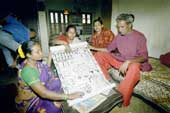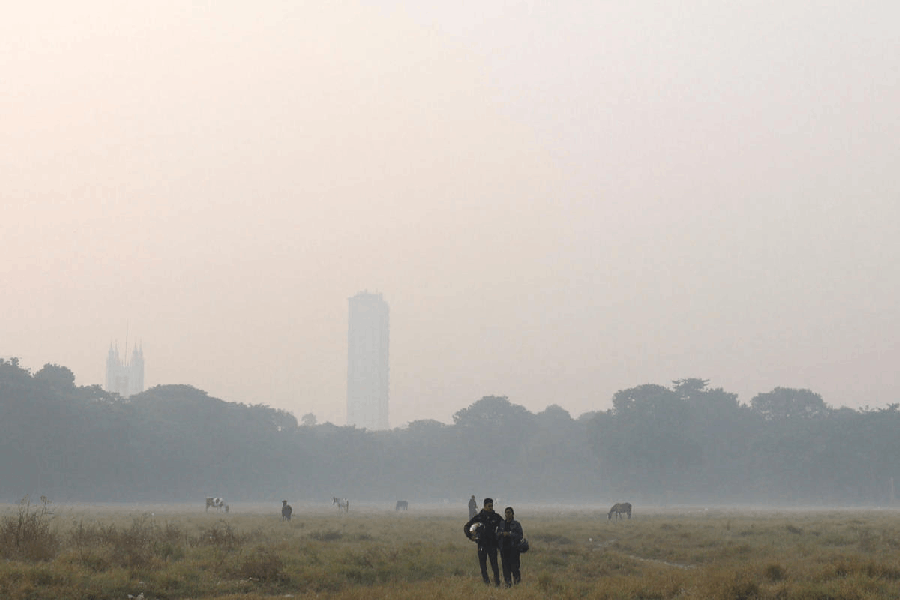 |
| Moyna, Rani, Swarna and Dukhu with the Tramjatra pata which shows the anarchy on Calcutta streets. Picture by Aranya Sen |
Moyna Chitrakar, Dukhushyam Chitrakar, Swarna Chitrakar and Rani Chitrakar had left Pingla village, in Midnapore, early on Wednesday for the home of their contact person in New Alipore. About 40 families of patuas live in the village. Besides being accomplished patuas of the scroll variety, they are very adept at composing impromptu songs on contemporary issues like AIDS, pulse polio vaccine, TB and, ironically, the virtues of literacy, in spite of them being unlettered, although scribbling their signatures is not beyond them.
All three have something else in common. In the past two years or so, they have all gone abroad at least once in connection with projects meant either to highlight Indian folk art or juxtapose it with art of urban origin. Moyna and Dukhu visited Melbourne in October last year as participants of the Tramjatra project, meant to bring Calcutta and Melbourne close to each other. Moyna had replaced Swarna at the last moment because the latter was expecting. About the same time last year, Rani participated in the Edinburgh Festival.
Rani starts displaying her scrolls. She says she uses only vegetable dyes, although for large projects she does not mind using the commercially-produced variety. She starts singing a song in piping tones, in which she says her lack of education is to blame for her poverty. Going by her example, her audience should have the good sense to learn their three R’s. Some of her more traditional patas are based on Manasamangal and other folk verse. Though Islamic by faith, they worship the gods and goddesses of the Hindu pantheon.
In Dukhu’s patas, fact meets fantasy as two horses gallop through a landscape of highrises and an aeroplane flies above, in recollection of his trip to Italy. He says all the patuas are forced to work on the side to eke out a living. Or else they have to resort to “ferimenti” — a curious word, which, he explained, meant shamming illness to win the sympathy of people, and thereby not having to sing for one’s supper, as they do literally.
Moyna is the youngest and she has a quirky sense of humour, expressed in her Tramjatra pata. It begins with a self-portrait of an artist as a pata painter. The next frame is Calcutta with a static fan in the ceiling. Here, the Indian women are in trousers. She is on her way to the airport in a street clogged with traffic. Walking through a metal detector to board the plane, which for her still resembles a blimp. In Melbourne, the traffic is well ordered, the trams anthropomorphic, whereas in Calcutta it is totally chaotic, resulting in street accidents and death. Australians wear glasses and record the patuas in action with their handycam.
The patuas are happy they went abroad but that has not changed the fact that they are always in debt. “Patas aren’t vegetables that people will buy them”, says Dukhu bravely. But they have no regrets. “Whenever we need some money, we go around singing our patas. That’s fun and we forget what the future holds for us”, says Rani. She really has no choice.











